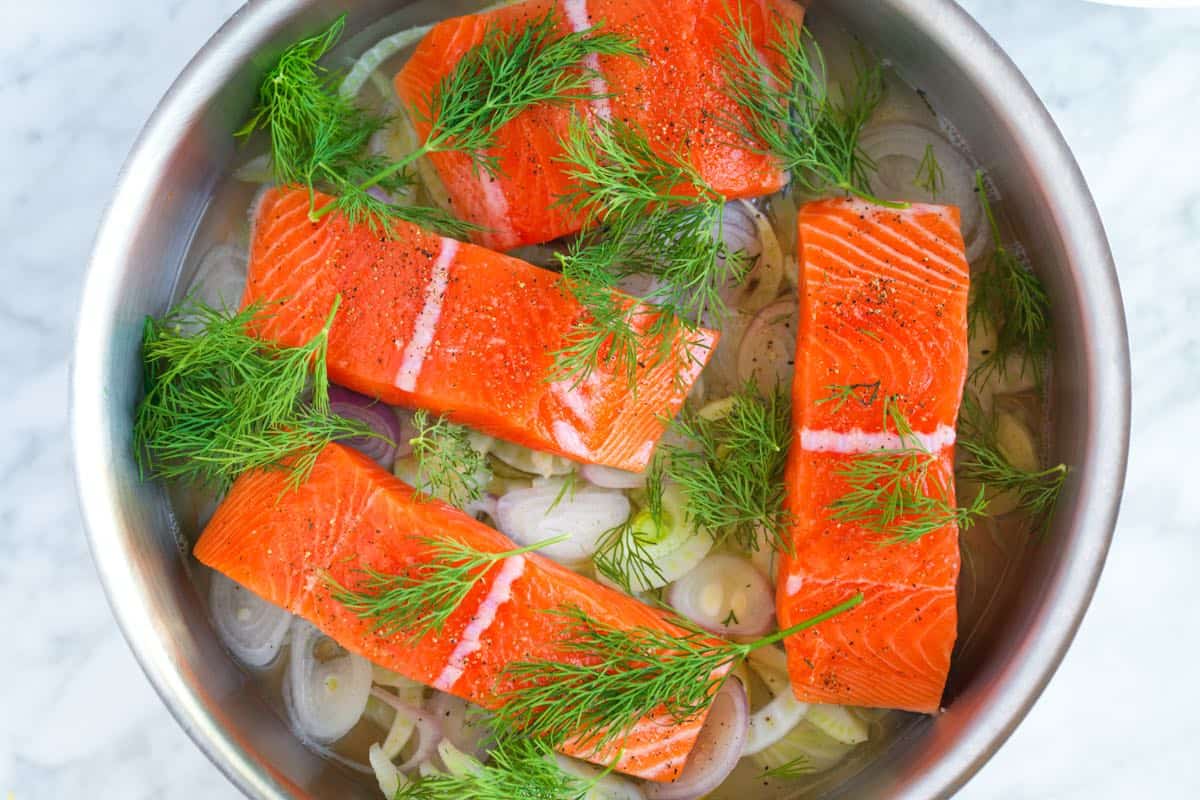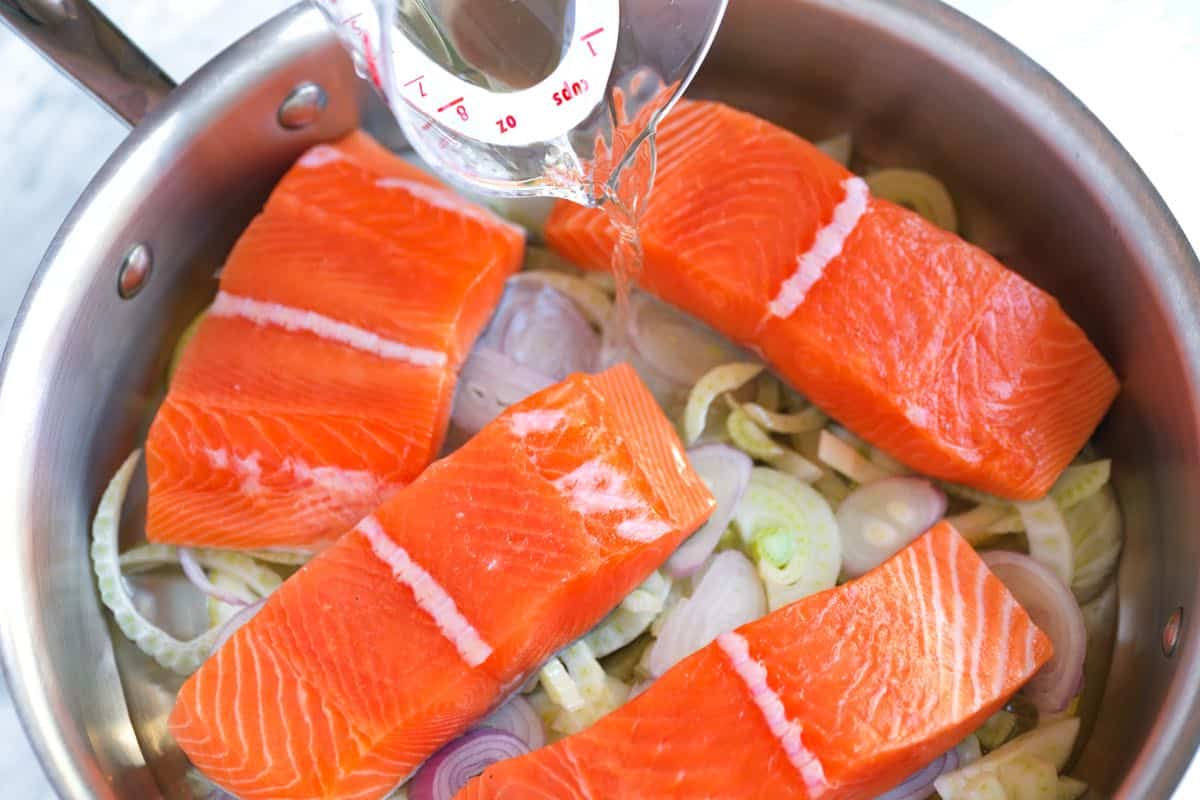This amazing poached salmon recipe makes the most tender, mouth-watering salmon you’ll ever have. It’s also easy and practically no-fail. This is truly one of the best ways to cook salmon.
When I make this poached salmon recipe, I can’t stop. I’m sure you’ll feel the same way after you try it. Poaching salmon is so easy to do.
It’s tasty to poach salmon with water, salt, and pepper, but my favorite aromatic poaching liquid (shown below) is even better. Enjoy your salmon on salads, flaked over toast, with creamy grits, or serve with roasted veggies.
Poaching is one of the healthiest ways to cook salmon. It retains moisture, flavors, and nutrients. Fresh salmon is best, but you can also poach frozen salmon fillets and get great results.
Learning the proper techniques for poaching frozen salmon delivers tender, flaky texture and delicious flavor. Follow these tips for poaching frozen salmon fillets just right every time
Should You Thaw Salmon Before Poaching?
Many recipes call for thawing frozen salmon completely before cooking However, partially thawing produces the best poached salmon texture
Fully thawing salmon causes the proteins to break down too much. This leads to mushy, easily overcooked results when poaching.
For ideal texture, poach salmon while it’s still partially frozen. Defrost just enough so the outer layer becomes malleable.
The center should remain frozen. This helps the fish hold its shape during cooking.
How to Safely Thaw Frozen Salmon
Here are a couple recommended ways to safely thaw salmon for poaching:
- Refrigerator thawing: Place frozen salmon fillets in a bowl in the fridge. Allow to sit overnight or for 24 hours.
- Cold water thaw: Put salmon in a sealed bag and submerge in cold tap water. Replace the water every 30 minutes. Thaw until just malleable on outside.
Once thawed to the proper point, pat the salmon dry with paper towels before poaching.
Do not thaw at room temperature or in hot water. This causes bacteria growth and outer layers to cook prematurely.
Poaching Partially Frozen Salmon
With the salmon thawed just to a pliable outer layer, you can begin poaching:
- Place salmon fillets in a shallow pan and add cold poaching liquid to almost cover. For flavor, try fish stock, vegetable broth, white wine, or water with aromatics.
- Bring the liquid to a gentle simmer over medium heat. Do not let it boil rapidly.
- Cover the pan and poach for 10-12 minutes. Check for doneness by flaking the thickest part with a fork.
- Salmon is done when it flakes easily and is opaque throughout. The center should reach 145°F on a food thermometer.
- Remove from poaching liquid gently with a slotted spatula.
Poaching while still partially frozen prevents the salmon falling apart easily. The outer thawed layer cooks through, while the frozen center helps retain the shape.
Ideal Thickness for Poached Frozen Salmon
Aim for evenly thick salmon fillets around 1-1 1/2 inches thick.
Thinner salmon will overcook too quickly when poaching from frozen. Meanwhile, much thicker fillets may not heat evenly all the way to the center.
Portioning the salmon into uniform thickness helps ensure even, thorough cooking.
Seasoning and Serving Poached Frozen Salmon
Once cooked, you can season or serve poached frozen salmon in many ways:
- Drizzle with olive oil and lemon juice or vinegar for brightness
- Sprinkle with fresh herbs, salt, pepper, garlic powder or onion powder
- Serve over fresh greens for an easy salmon salad
- Flake into grains like rice or quinoa
- Pair with roasted vegetables or side salad
Storing and Reheating Leftovers
Properly stored, poached frozen salmon keeps 3-4 days refrigerated or 2-3 months frozen.
To reheat, place in a skillet with a splash of liquid, cover, and gently warm. Check internal temperature to ensure it reaches 145°F when reheated.
Handy Tips for Poaching Frozen Salmon
Keep these tips in mind for perfect poached frozen salmon every time:
- For safety, thaw just until malleable on the outer layer before poaching
- Use 1-1 1/2 inch thick fillets for even cooking
- Poach at a gentle simmer, not a rapid boil
- Check for doneness by flaking with a fork and final internal temperature
- Store poached salmon 3-4 days refrigerated or 2-3 months frozen
With the right preparation, poaching frozen salmon yields impressive results! The fish turns out moist, flavorful and tender.
Give this method a try the next time you want to transform frozen salmon fillets into a delicious, healthy meal. Poaching partially frozen fish helps simplify the process while ensuring ideal texture.
Frequently Asked Questions About Poaching Frozen Salmon
Still have questions about properly poaching frozen salmon fillets? Here are answers to some common queries:
Is it OK to poach salmon straight from the freezer?
Yes, you can poach salmon directly from frozen. But it is best to thaw it partially to prevent the fish overcooking and becoming mushy.
Does poaching frozen salmon take longer?
It takes about the same amount of time – 10-12 minutes per inch of thickness. Partially frozen salmon holds its shape better, so cook time is similar to fresh.
Can you use milk to poach frozen salmon?
Milk can be used to poach salmon, but water, broth or wine allow you to better control seasoning and flavors.
Should you sear salmon before poaching from frozen?
Searing before poaching is not necessary. Partial freezing helps the salmon hold its shape during cooking.
Is poached frozen salmon safe to eat?
Yes, poached frozen salmon is safe to eat when thawed and cooked properly to an internal temperature of 145°F.
Can I add seasoning directly to poaching liquid?
Yes, add salts, pepper, herbs, garlic, or spices to infuse the salmon with flavor as it poaches.
Is poached frozen salmon good for meal prep?
Poached salmon works great for meal prep! Store in the refrigerator 3-4 days. You can also freeze meal prep portions.
How can I add flavor to poached frozen salmon?
Drizzle with olive oil, sprinkle with herbs, serve with lemon slices, or top with chopped veggies for extra flavor.
Master Poaching Frozen Salmon
Now you have all the information needed to perfectly poach frozen salmon fillets. With the right technique, partially thawed salmon comes out tender and delicious straight from the freezer.
Use this guide to take your poached salmon game to the next level. Impress yourself, family and friends with your mastery of this healthy, flavorful cooking method.

How to Poach Salmon
Poaching is one of the best ways to make salmon, especially if you want moist and tender results. It works the same way for chicken breasts and shrimp! To poach salmon, put seasoned fillets in a skillet on top of a bed of aromatics like shallots and lemon slices.

I keep the skin on my salmon fillets. The skin is easier to peel off after cooking, and it keeps the salmon from getting too done by blocking heat from below.
Add liquid (white wine or broth), and bring to a simmer. Put a lid on the pan and turn down the heat to low. Let the salmon fillets poach until they are easy to flake with a fork.

Salmon poached in a container that keeps air out will last up to 4 days in the fridge or up to 1 month frozen. Thaw frozen poached salmon in the refrigerator overnight before reheating.
To reheat poached salmon, place it in an oven-safe dish. Add a splash of water or broth for extra moisture. Cover the dish with aluminum foil to prevent drying. Bake for about 15 minutes, or until the salmon reaches an internal temperature of 125°F to 130°F.
